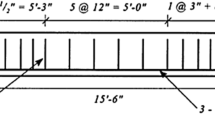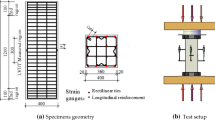Abstract
Model uncertainty associated with the maximum strength, ductility and toughness of high strength concrete confined by rectilinear ties is statistically quantified for ten analytical models. These models are applied to predict the results of 108 large-scale specimens tested under uniaxial compression. An empirical model is proposed for the complete description of the stress-strain curve of tie-confined high strength concrete and proves to be in good agreement with the aforementioned data.
Résumé
L’incertitude du modèle vis-à-vis de la résistance, de la ductilité et de la dureté du béton à haute résistance confiné par armature transversale rectangulaire est évaluée pour dix modèles de calcul. Ces modèles sont utilisés pour évaluer les résultats de 108 spécimens à grande échelle soumis aux sollicitations de compression uniaxiale. Un modèle empirique est ensuite proposé pour la description complète de la courbe contrainte—déformation du béton à haute résistance confiné par armature transversale, et elle se trouve en bon accord avec les résultats expérimentaux cités cidessus.
Similar content being viewed by others
References
Cusson, D. and Paultre, P., ‘Confinement model for high strength concrete tied columns’, Report No. SMS-9302. Department of Civil Engineering, University of Sherbrooke. Quebec 1993, Canada.
Sun, Y. P. and Sakino, K., ‘Ductility improvement of reinforced concrete columns with high strength materials’Transactions of the JCI 15 (1993) 455–462.
Sun, Y. P., Oba, F. S., Tian, F. S. and Ikeda, L., ‘Confinement effects of transverse hoops in high strength concrete’. CD ROM Proceedings of the 11th World conference on Earthquake Engineering, Acapulco (1996), Mexico, Paper No. 1363.
Fafitis, A. and Shah, P. S., ‘Lateral remforcement for high strength concrete columns’, ACI, SP-87, Detroit (1985), 213–232.
Yong, Y. K., Nour, M. G. and Nawy, E. G., ‘Behaviour of laterally confined high strength concrete under axial loads’,Journal of Structural Engineering, ASCE 114 (2) (1988) 332–351.
Bjerkeli, L., Tomaszewicz, A. and Jensen, J. J., ‘Deformation properties and ductility of high strength concrete’, Proceedings of the 2nd International Conference on Utilization of High Strength Concrete, Berkley, California (1990), 215–238.
Nagashima, T., Sugano, S., Kimura, H. and Ichikawa, A., ‘Monotonic axial compression test on ultra high strength concrete tied columns’, Proceedings of the 10th World Conference on Earthquake Engineering, Madrid (1992), Spain, 2983–2988.
Muguruma, H., Nishiyama, M. and Watanabe, F., ‘Stress-strain curve model for concrete with a wide range of compressive strength’, Proceedings of the 3rd International Conference on Utilisation of High Strength Concrete, Lillehammer (1993), Norway, 314–321.
Li, B., ‘Strength and ductility of reinforced concrete members and frames constructed using high strength concrete’, Research Report 94-5, University of Canterbury, (1994) Christchurch, New Zealand.
Ibrahim, H. H. H., and MacGregor, J. G., “Flexural behaviour of laterally reinforced high strength concrete structures’,ACI Structural Journal 93 (6) (1996) 674–684.
Diniz, S. M. C. and Frangopol, D. M., ‘Strength and ductility simulation of high strength concrete columns’Journal of Structural Engineering, ASCE 123 (10) (1997) 1365–1374.
CEN Techn. Comm. 250/SC8, ‘Eurocode 8: Earthquake Resistant Design of Structures-Part 1: General Rules and Rules for Buildings’ (ENV 1998-1-1/2/3). CEN. (1995) Berlin.
Sheikh, S. A. and Uzumeri, S. M., ‘Analytical model for concrete confinement in tied columns’,Journal of the Struct. Div., ASCE 108 (ST12) (1982) 2703–2722.
Cusson, D. and Paultre, P., ‘Behaviour of high strength concrete columns confined by rectangular ties under concentric loading’, Report No. SMS-9202, Department of Civil Engineering, University of Sherbrooke, (1993) Quebec, Canada.
Razvi, S.R. and Saatcioglu, M., ‘Confinement of high strength concrete columns for seismic application’, CD ROM Proceedings of the 11th World conference on Earthquake Engineering, Acapulco (1996), Mexico, Paper No 1855.
Cook, J. E., ‘Research and application of high strength concrete: 10000 psi concrete’,Concrete International 11 (10) (1989) 67–75.
CEB Working Group on HSC/HPC, ‘High performance concrete. Recommended Extensions to the Model Code 90. Research Needs’.CEB Bulletin d’Information 228 (1995).
Kappos, A. J., Chryssanthopoulos, M. K. and Dymiotis, C., ‘Probabilistic assessment of European seismic design practice for contined members’,European Earthquake Engineering XII (3), (1998) 38–51.
Author information
Authors and Affiliations
Rights and permissions
About this article
Cite this article
Kappos, A.J., Konstantinidis, D. Statistical analysis of confined high strength concrete. Mater Struct 32, 734–748 (1999). https://doi.org/10.1007/BF02905070
Received:
Accepted:
Issue Date:
DOI: https://doi.org/10.1007/BF02905070




